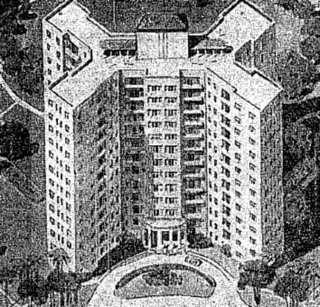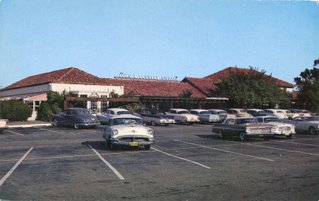
This photo was published in the Los Angeles Times in 1943 when the first phase of PLB opened for residency. The original concept was less vast than it is now. One, two and three-bedroom apartments were clustered from Fairfax to east Colgate and between Third and Sixth Streets.
At left an obliging young lady poses here with the first finished courtyard. The eucalypts are young but the buildings look the same, give or take a paint job or two.
The complex was built "under war conditions", i.e., with special permits intended to provide post-war housing for returning WWII vets. The National Housing Agency set rentals at $52 - $54 for one-bedroom apartments, $65 to $74 for two-bedroom, and $78 to $80 per month for three-bedrooms.
By 1944 there were 1,316 units available for rental...assuming you weren't African-American or Jewish. Like many communities in Southern California, until the nineteen-fifties Parklabrea was "restricted", using the euphemism popular at the time.
Foundations for more garden apartments were already under construction when Met Life, the
owners, switched gears and decided that vertical housing might be even more lucrative. By 1947 their plans included towers---a good cluster of them, no more than 13-stories high, something like this artist's rendition from 1947.
To accomplish this the existing foundations for unbuilt garden apartments had to be ripped out and cleared to make way for the towers. Leonard Schultze & Associates, the New York architectural firm responsible for jazz-age hotels in Manhattan, designed the towers, which explains why they have a bit of Art-deco aftertaste.
In addition to the towers, three courtyard groups were also

constructed along the northeastern edge of the development. They were a little more sleek than their earlier brethren, using steel cabinetry in the kitchens instead of the wood found in earlier designs. Thomas Church, who landscaped UC Berkeley, Stanford University, and the Sunset magazine headquarters in Palo Alto, was brought in to design Parklabrea's gardens, which then (as now) were pretty much locked into midcentury themes.
By the time the Towers opened for residency in 1950 rents had gone up from $115 to $180 per month. Parking structures included 24-hour attendants and a trackless trolly system was extended to 3rd and Fairfax to enable Parklabreans to get around.
So far, so good....








